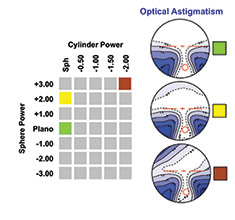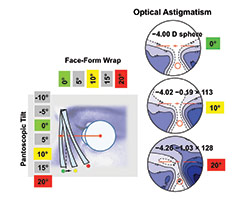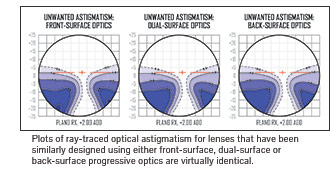|
Your monthly guide to staff training outside the box
Eyes / Lenses / Fitting Lenses / Free-Form / Frames / Sunwear / Patient Solutions / In-office / Standards
LENSES, Free-Form
Success With Personalized
Lenses Requires Patient Education
By Rajeev Raghu, OD, FAAO
Offering personalized lenses is a premium option that can set you apart from competing practices and online optical retailers. Succeeding with this high-performance, high-ticket vision solution requires educating the patient—again and again.
See Plus »
|
NOT THE BASE CURVE'S IDEAL POWER?

What happens as the prescription deviates from a base curve's ideal power? The chart illustrates how optical performance eteriorates away from the ideal power using the same base curve. In the example, the plano lens is the targeted progressive lens design. As the power changes, the use of that same base curve degrades the optics by introducing oblique astigmatism, a low-order aberration, becoming worse in higher powers. In addition, a conventional lens design cannot address the aberrations produced simultaneously by both the sphere and cylinder power. The result is a further compromise for the astigmatic patient, especially in higher cylinders.
See Plus »
|
|


|
WHAT SHOULD YOU DO?
- For the very next flat top patient with more than 1D cyl, order an atoric lens. In fact, an atoric lens in SV, FT and traditional progressives works great. Patients will notice the difference in vision.
- For the next higher power and/or higher cyl patient, sell an optimized SV lens. The entire lens will be redesigned for that patient's Rx in the frame that they chose. To further refine the lens, consider taking and supplying your own tilt, wrap and vertex measurements.
- For patients with Rxs near plano, spend the extra money, for now, on a pair of Rx sunglasses.
See Plus »
|
AS TILT AND WRAP CHANGE

As the pantoscopic and/or face-form tilt of the lens in the position of wear increases, optical performance deteriorates because of oblique astigmatism due to lens tilt. The diagram illustrates how the power changes as tilt changes. The result is a lens whose effective powers become farther and farther from the prescribed powers. If one of these examples had been purchased by one of your patients from the Internet (in the mistaken belief that all lenses are probably the same), an understanding of these issues becomes an opportunity to deliver a better solution by better wavefront management.
See Plus »
|
The Optics of Free-Form Progressive Lenses

By Darryl Meister, ABOM
Regardless of the type of free-form lens, the placement of the actual progressive optics, whether on the front surface, back surface or split between both, has minimal impact on the magnitude of the inherent unwanted astigmatism of the design. Because a typical spectacle lens represents an "optical system" of fairly negligible thickness, the optics of each surface are essentially additive. Consequently, the inherent unwanted astigmatism of progressive lenses is not significantly influenced by placement of the progressive optics.
Although the inherent astigmatism may not differ appreciably, placing the progressive optics on the back surface can minimize unwanted magnification effects. Skew distortion, an aberration that causes objects to appear sheared or "bowed" through the periphery of progressive lenses, is due both to magnification changes created by differences in curvature (or "shape") across the front surface and to magnification changes as a result of the unwanted cylinder power produced by these differences in curvature. Placing the progressive optics on the back surface of the lens eliminates the contribution of the front surface to these magnification changes. Moreover, because the progressive viewing zones are brought closer to the eye, slightly wider fields-of-view may be obtained when the progressive optics are located on the back surface.
See Plus »
|
Free-form Lens Technology
What does it really mean to your patients and your business?
By Maggie Sayers, ABOM
Free-form progressive lenses are: Individually measured, computed and manufactured progressive addition lenses using computer programs to run three-axis generators and polishers to provide the wearer with an optimized lens correction for a visual defect.
The process consists of three separate but totally dependent parts:
- A progressive lens design
- A software program
- Very specific processing equipment
See Plus »
|
WEIGHTED DESIGNS
Matching the patient to a weighted design lens provides a further tool to get the lenses right. For example, today's mobile lifestyle changes "normal" reading position and posture. If one asks, "Tell me about your work—where do you do your most reading, show me how you hold the book (tablet and/or smartphone) and the first two reasons that you wear prescription glasses," it's easy to suggest a Near-priority (N), Far-priority (F) or Balanced (B) SEIKO Superior progressive lens platform. Use Near for indoor/office environments where there's a need for clear, stable, prolonged near vision. Presbyopes who use their eyewear mainly for distance and outdoor work where a clearer and wider periphery enhances the field of view (truck driver, myopes where reading is less in demand) would notice a difference with distance vision optimized. For new presbyopes and people whose demands vary widely, use a balanced design lens.
See Plus »
|
|